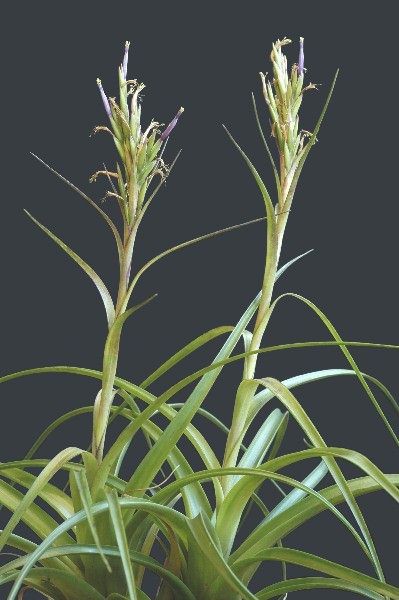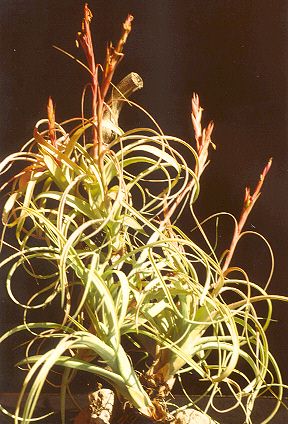


This all started with Linnaeus in 1762. I do not have access to his description of this plant although I do have that in Baker’s Bromeliaceae (1889) which states “branch-bracts small, ovate, green”. This is confirmed in Mez 1935. However, Smith reduced T. parvispica (from South Brazil) to a synonym of T. polystachia but ignored Baker’s description of T. parvispica which said “branch-bracts ovate with long linear points”. This T. parvispica was resurrected by Luther in De Rebus I (1994) but he gave no reason for his action. At the same time he reduced T. pfisteri Rauh Bromelien Studien XV (1984) from Recife Brazil to synonymy under T. parvispica.
Let us now go to 1977 when Flora Neotropica No 14 part II was published. T. polystachia sensu Smith is widespread and was reputedly from Florida, West Indies, Mexico to Brazil and Bolivia. The Florida reference can now be deleted because it appears that Lyman Smith was referring to the now T. x smalliana. While the plant seems more common in the Northern Hemisphere Lyman Smith decided to use a drawing of Foster’s 1140 which had been collected in Mato Grosso but which clearly showed the elliptic, acute primary bracts which are much shorter than the spikes.
To digress, in 1989 this same drawing of Foster’s 1140 was used in J. Bromeliad Soc. 39(1):24 to illustrate T. xsmalliana but this is incorrect. A photograph of a true T. x smalliana may be viewed on http://fcbs.org
In 1983 in Feddes Repertorium, Wilhelm Weber described T. belloensis (see photo by R Ehlers) citing a collection made by Renate Ehlers in 1982. In 1992 Lloyd Kiff in Distributional Check-List of the Genus Tillandsia made T. belloensis synonymous with T. polystachia but prompt action by Renate Ehlers in Bromeliad Society Inc. Journal 1993 p74 reinstated T. belloensis to its correct status.
In Flora Novo-Galiciana McVaugh (1989) we read for T. polystachia “Primary bracts elliptic, acute, long acuminate or caudate, their tips (blades) surpassing the proximal spikes”. No comment was made to its difference from that in previous descriptions by others.
In January 2000 Andrew Flower from New Zealand wanted to know why my Tillandsia key in Http://fcb.org did not work for T. polystachia because he had grown on seed by this name and the plants just did not fit! T. belloensis was not in my Key at that time purely because I did not think it was common in collections. This prompt by Andrew reminded me of Renate Ehlers’ article in the BSI Journal in 1993 and I supplied him with my translation of Weber’s description of T. belloensis. His plants fitted the description! The key was quickly updated because clearly T. belloensis was much more common than I thought. I even found its photograph in Isley’s Tillandsia book (1987) under the name of T. polystachia. This really set alarm bells ringing and - shock - horror the error was still with us in Hiroyuki Takisawa’s Tillandsia Handbook. On page 78 the white flowered form of T. polystachia seems correct but the plant said to represent a typical T. polystachia is typical T. belloensis. On page 3 where T. belloensis is featured, this seemed to have a much narrower spike than a typical T. belloensis but further investigation has revealed that the plant is within the description.
These discrepancies had me contacting Renate Ehlers and her penchant for detail now has me the proud owner of 22 photocopies of herbarium specimens from all manner of places from this polystachia/parvispica/belloensis complex.
Clearly the closest to T. polystachia sensu Smith is Ehlers EM82212 found near Nejapa in Oaxacana, Mexico. (see Photo by R Ehlers).
I think I can now tell the difference between these three species but much overlapping of habitat and slight variations in form has convinced me that 22 herbarium specimens is but a start to truly solve this puzzle.
A key to the three species and one natural hybrid, under current interpretation based on my own Tillandsia key is as follows:-
Petal color – blue/violet, Stamens – longer than petals, Inflorescence – compound, Plant – not with grass-like leaves, Scape – protruding from the leaf rosette, Floral bracts – close together and rhachis not visible, Spikes – sword-shaped more than 4 flowered,
Leaves forming an open funnel-shaped rosette -> 1.
Leaves at base forming an oval to cylindric bulb and then spreading wide = x smalliana
1. Primary bracts – elliptic and acute, shorter than spike, Inflorescence – dense, cylindric to spindle shaped to 30cm long, Floral bracts – glabrous, Leaves green. = polystachia
1a. Primary bracts – narrow triangular, shorter than the spike but longer than the sterile section, Inflorescence lax with upright spikes, floral bracts – sparsely scaled and exceeding the sepals. Leaves strong, whitish grey = parvispica
1b. Primary bracts – narrow triangular with long blade, Sheath – of those for the basal spike equals the spike and the blade much surpasses, Inflorescence – upright with spikes partly erect and visible especially in the top section, Floral bracts – glabrous, green with red edges. Leaves green. = belloensis
Fulham, South Australia